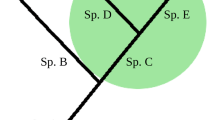Summary
The chromosome numbers of 40 ant species are reported. For 22 species the karyotypes as well as the chromosome numbers are presented. The chromosome numbers range between n=8 and n=26. Remarkable karyotypes are those of the genusLasius in exhibiting mainly acrocentric chromosomes. In all other karyotypes the majority of chromosomes show medio- or submediocentric centromere position.
Differences in chromosome numbers in the genusCamponotus reflect the grouping in subgenera with the exception ofTanœmyrmex. This pattern is not true for the generaAphœnogaster andLeptothorax, where a variety of chromosome numbers were found in the different subgenera.
Zusammenfassung
Die Chromosomenzahlen von 40 Ameisenarten werden mitgeteilt. Für 22 Arten wird zusätzlich der Karyotyp vorgelegt. Die haploiden Chromosomenzahlen bewegen sich zwischen n=8 und n=26. Bemerkenswert sind die Karyotypen der GattungLasius. Diese Karyotypen besitzen, abgesehen von einem oder zwei mediozentrischen Paaren, ausschliesslich acrozentrische Chromosomen. Alle übrigen Karyotypen bestehen überwiegend aus medio- bzw. submediozentrischen Chromosomen.
In der GattungCamponotus entspricht die Gruppierung in Untergattungen auch einer Gruppierung von unterschiedlichen Chromosomenzahlen. Für die GattungenAphœnogaster undLeptothorax gilt diese Entsprechung nicht.
Similar content being viewed by others
References
Bernard F., 1968.—Les fourmis (Hymenoptera, Formicidœ) d'Europe occidentale et septentrionale. Masson édit., Paris, 411 p.
Buschinger A., 1971.—Zur Verbreitung der Sozialparasiten vonLeptothorax acervorum (Fabr.) (Hym., Formicidæ).Bonn. Zool. Beitr., 22, 322–331.
Crozier R.H., 1970 (a).—Karyotypes of twenty-one ant species (Hymenoptera, Formicidæ), with reviews of the known ant karyotypes.Can. J. Genet. Cytol., 12, 109–128.
Crozier R.H., 1970 (b).—Pericentric rearrangement polymorphism in a north american Dolichoderine ant (Hymenoptera: Formicidæ).Can. J. Genet. Cytol., 12, 541–546.
Crozier R.H., 1975.—Animal Cytogenetics. Vol. 3, Insecta 7. Hymenoptera (ed. B. John). Gebrüder Borntraeger, Berlin and Stuttgart, 95 p.
Crozier R.H., 1977.—Genetic differentiation between populations of the antAphœnogaster “rudis” in the southeastern United States.Genetica, 47, 17–36.
Emery C. 1922.—Hymenoptera, Fam. Formicidæ, Subfam. Myrmicinæ. In:Genera Insectorum, 174, ed. P. Wytsman, 397 p.
Emery C., 1925.—Hymenoptera, Fam. Formicidæ, Subfam. Formicinæ. In:Genera Insectorum, 183, ed. P. Wytsman, 302 p.
Goñi B., 1980.—Personal comm. onCamponotus karyotypes.
Hauschteck E., 1962.—Die Chromosomen von fünf Ameisenarten.Rev. Suisse Zool., 68, 218–223.
Hauschteck E., 1962.—Die Chromosomen einiger in der Schweiz vorkommender Ameisenarten.Vierteljahrssch. Naturforsch. Ges. Zürich, 107, 213–220.
Hauschteck-Jungen E., Jungen H., 1976.—Ant chromosomes. I: The genusFormica.Ins. Soc., 23, 513–524.
Hung A.C.F., 1969.—The chromosome numbers of six species of formicine ants.Ann. Entomol. Soc. Am., 62, 455–456.
Imai H., 1966.—The chromosome observation techniques of ants and the chromosomes of Formicinæ and Myrmicinæ.Acta Hymenopterol., 2, 119–131.
Imai H., 1969.—Karyological studies of Japanese ants. I: Chromosome evolution and species differentiation in ants.Sci. Rep. Tokyo Kyoku Diagaku, Sect. B,14, 27–46.
Imai H., 1971.—Karyological studies of Japanese ants. II: Species differentiation inAphœnogaster, with special regard to their morphology, distribution and chromosomes.Mushi, 44, 137–157.
Imai H., 1974.—B-chromosomes in the myrmicine ant,Leptothorax spinosior.Chromosoma, 45, 431–444.
Imai H., Kubota M., 1972.—Karyological studies of Japanese ants (Hymenoptera, Formicidæ). III: Karyotypes of nine species in Ponerinæ, Formicinæ, and Myrmicinæ.Chromosoma, 37, 193–200.
Imai H., Kubota M., 1975.—Chromosome polymorhism in the ant,Pheidole nodus.Chromosoma, 51, 391–399.
Imai H., Crozier R.H., Taylor R.W., 1977.—Karyotype evolution in Australian ants.Chromosoma, 59, 341–393.
Imai H. Yosida H., 1964.—Chromosome observation in Japanese ants.Annual Report of National Institute of Genetics, 15, 64–66.
John B., Lewis K.R., 1968.—The chromosome complement Springer Verlag, Wien New York, 206 p.
Kumbkarni C.G., 1965.—Cytological studies in Hymenoptera. III: Cytology of parthenogenesis in the formicid ant,Camponotus compressus.Caryologia, 18, 305–312.
Kutter H., 1977.—Hymenoptera, Formicidæ. In:Insecta helvetica 6. Ed. W. Sauter, Zürich. Schweizerische Entomologische Gesellschaft, 298 p.
Pearson B., 1980.—Personal comm. on the karyotype ofL. alienus.
Taylor R.W., 1978.—Nothomyrmecia macrops: a living-fossil ant rediscovered.Science, 201, 979–985.
White M.D.J., 1973.—Animal Cytology and Evolution. Third ed. at the University Press, Cambridge, 961 p.
Wilson E.O., 1955.—A monographic revision of the ant genusLasius.Bull. Mus. Comp. Zool. Harvard, 113, 1–201.
Wilson E.O., Carpenter F.M., Brown W.L., 1967.—The first Mesozoic ants.Science, 157, 1038–1040.
Author information
Authors and Affiliations
Additional information
Supported by: KarlHescheler-Stiftung, Georg und AntoineClaraz-Schenkung, and by grants of the Schweizerischer Nationalfonds zur Förderung wissenschaftlicher Forschung Nr. 4326, 4847, 3.187.69.
The former students PeterDuelli, HansHosbach, and OthmarKuhn took part in the chromosome studies.
Rights and permissions
About this article
Cite this article
Hauschteck-Jungen, E., Jungen, H. Ant chromosomes. Ins. Soc 30, 149–164 (1983). https://doi.org/10.1007/BF02223865
Received:
Accepted:
Issue Date:
DOI: https://doi.org/10.1007/BF02223865




